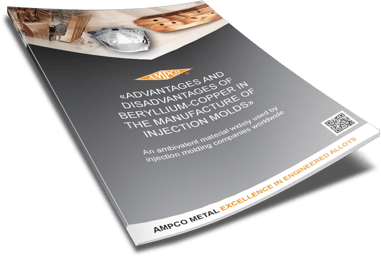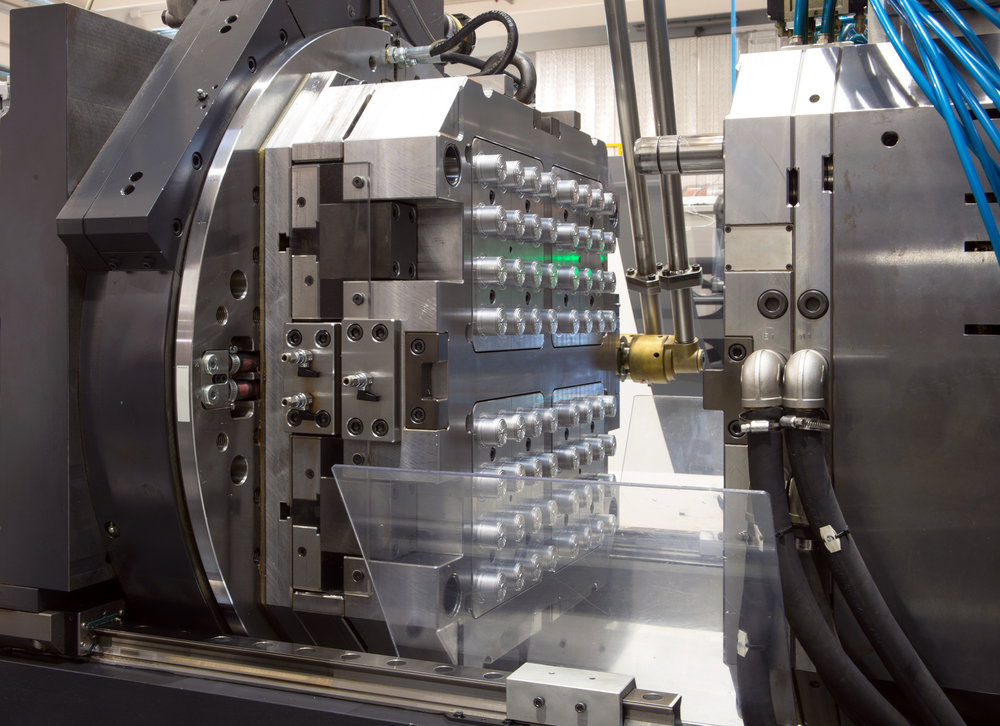Manufacturers know that there are certain time losses in production that have to be accepted and cannot be eliminated. In plastics production, a specific time loss occurs when the molten plastic cools down inside the mold. Water runs through the mold to accelerate the process, and it seems that is all that can be done to reduce this downtime. However, manufacturers in the plastics industry should direct their attention to something they may not have thought hard enough about until now: the material the injection mold is made of.
Different materials have different properties that make them well-suited for injection molds. If plastic is to be cooled down, a key metric to watch out for is thermal conductivity. The more thermally conductive a material is, the quicker it can be heated and cooled and the quicker the production of parts can be completed. If, for instance, you use an injection mold made of iron, the best thermal conductivity you can expect is somewhere around 60 W/m K, which is not much compared to what other materials can achieve.
In the field of plastic injection molds, producers are very careful when it is time to decide which basic material should be used for their molds. Up to now, some companies still use conventional tool steels, but if this material is less expensive for the buyers’ side, it still presents a lot of inconveniences compared to high conductivity copper alloys.
The best possible choice when it comes to injection mold materials is copper based alloys. The average thermal conductivity of copper is about 399 W/m K, which is 60 % better than aluminum and 3000 % better than stainless steel. Copper is second only to silver in this regard, which as a precious metal is not a sensible choice for manufacturers. Combining copper with materials like beryllium or nickel, silicone and chrome results in alloys that offer an optimal combination of hardness, wear resistance, thermal fatigue and thermal conductivity.
Mr. Luis J. Bento, Chairman of AMPCO METAL, explains: “Cycle time can be reduced by at least 20 percent, and some users report reductions of up to 80 percent, resulting from the significantly faster cooling rates achieved with AMPCOLOY® alloys. This means that productivity can be increased by at least 25 percent, with some users in the automobile headlight production industry reporting up to a 500 percent production increase simply because a reduced cycle time means more components can be made per shift.”
But gains in productivity can not only be also achieved due to their conductivity. The excellent polishing ability of AMPCOLOY® alloys has been proven when used in contact lens packaging manufacture, which requires the packaging to be transparent so the lenses can be checked through the packaging. Such high quality plastic packaging is achieved with high conductivity copper alloy inserts that are highly polished. The polishing time of such inserts has proven to be four times faster than steel inserts, and the cycle time to be reduced by 57 percent.
Reduced warpage
Part warpage can be greatly reduced as, with the improved cooling, the molded component spends less time at an elevated temperature, thus the number and severity of “hot spots” within the mold are reduced and part quality is greatly improved. This means for the producer more constant part quality, shot after shot.
Heat removal
Due to the superior thermal transfer characteristics of high conductivity copper alloys, (typically five to 10 times better than steel), heat can be moved away from sensitive areas of the mold at such a rate that the need for complex cooling channels in the immediate location of the molded component is reduced, or eliminated altogether. Because the number of cooling channels required in the tool is less, the machining costs of the molds can be greatly reduced—up to four times less than that of a comparable cooling rate on a steel mold.
Diffusivity
High quality copper alloys absorb the heat wave in a mold when a plastic part is injected. The initial absorption of the heat wave is a key factor. Heat removal in the backstage with the cooling system leaves plenty of time to do it. This is where AMPCOLOY® alloys really stand for—absorbing the first heat wave, shot after shot.
Coating
In order to increase wear resistance, the high quality copper alloys can be very easily coated with electroless nickel, hard chrome or even PVD (physical vapor deposition) coatings. Electroless nickel allows the coating to penetrate into each and every hole with a constant coating thickness, which is not the case with a galvanic process, such as hard chrome plating. Hardness of up to 60 to 70 HRC can be achieved. For easier plastic part removal when demolding, electroless nickel can be combined with Teflon (PTFE) or boron nitride. Such mold parts have a surface that feels as slippery as soap when coated with PTFE or boron nitride electroless nickel, which results in molded plastic parts that will not stick and that will demold very easily.
Today, the users of plastic injection machines are under high price competition. Although the quality level for plastic injection products is not the same all over the world, more and more companies even in European countries buy installations with conventional steel molds. But at the end, they lose in terms of productivity all over the production cycle. AMPCO METAL offers a worldwide presence, also in emerging countries, to offer the same quality standard for products and service.
Get our new Technical Paper «Advantages and disadvantages of copper beryllium in the manufacture of injection molds» for free.





